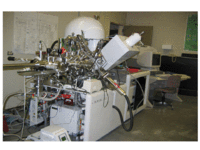
Photo from wikipedia
Electron- (ECWC) and ion- (ICWC) cyclotron wall conditioning are essential means for controlled fusion to modify the surface state of plasma-facing components in order to reduce impurity generation and fuel… Click to show full abstract
Electron- (ECWC) and ion- (ICWC) cyclotron wall conditioning are essential means for controlled fusion to modify the surface state of plasma-facing components in order to reduce impurity generation and fuel accumulation in the wall. Development of ECWC and ICWC requires characterization of neutral particle fluxes generated in discharges, because neutrals enhance the homogeneity of the conditioning, which may contribute to remote or shadowed areas, especially in the presence of a permanent magnetic field (e.g. W7-X, ITER). A time-of-flight neutral particle analyzer (ToF-NPA) with 4.07 m flight distance is employed to measure time- and energy-resolved low energetic (<1 keV) neutral particle distributions. The ToF-NPA setup tested at the EXTRAP T2R reversed field pinch was installed at the TOMAS toroidal plasma facility to determine low energy neutral particle fluxes while investigating the impact of the gas pressure in the instrument and compatibility with low count rates during EC- and ICWC discharges. TOMAS has a major radius of 0.78 m and provides various plasma operation conditions: toroidal magnetic field up to 0.12 T, EC frequency 2.45 GHz with the power of 0.6–6 kW, IC frequency of 10–50 MHz with the power of up to 6 kW. Early results on the characterization of three phases (EC only, EC + IC, and IC only) of hydrogen discharges demonstrate: (i) the low energy (10–725 eV) neutrals distribution has been determined by the NPA system, (ii) the mixed EC + IC phase produces the highest population of neutral particles, while the EC only provides one order of magnitude lower rate, (iii) the neutrals produced in IC only have higher average energy (28 eV) than EC only (7 eV) and EC + IC (16 eV).
Journal Title: Physica Scripta
Year Published: 2021
Link to full text (if available)
Share on Social Media: Sign Up to like & get
recommendations!